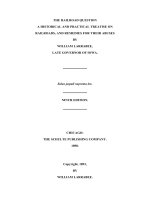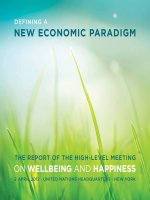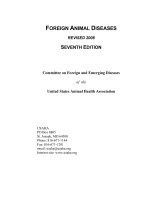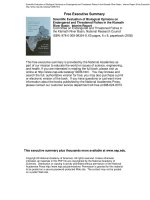The Teachings On Peace And Harmony Of The 14TH Dalai Lama And Selected Peace Advocates
Bạn đang xem bản rút gọn của tài liệu. Xem và tải ngay bản đầy đủ của tài liệu tại đây (1.97 MB, 202 trang )
i
THAI NGUYEN UNIVERSITY
Socialist Republic of Vietnam
BATANGAS STATE UNIVERSITY
Republic of the Philippines
THE TEACHINGS ON PEACE AND HARMONY OF THE 14TH
DALAI LAMA AND SELECTED PEACE ADVOCATES
A Dissertation
Presented to the
Faculty of the Graduate School
Batangas State University
Batangas City
In Partial Fulfillment
of the Requirements for the Degree of
Doctor of Philosophy
Major in English
By
TRAN THI NHI
2015
ii
THAI NGUYEN UNIVERSITY
Socialist Republic of Vietnam
BATANGAS STATE UNIVERSITY
Republic of the Philippines
iii
THAI NGUYEN UNIVERSITY
Socialist Republic of Vietnam
BATANGAS STATE UNIVERSITY
Republic of the Philippines
ABSTRACT
Title
:
Teachings on Peace and Harmony of the 14th Dalai
Lama and Selected Peace Advocates
Author
:
Tran Thi Nhi
Course
:
Doctor of Philosophy
Major
:
English language and literature.
Year
:
2014
Adviser
:
Dr. Maria Luisa A. Valdez
Summary
There exist myriad problems in the current world which threaten the
existence of humanity. Violence is accelerating everywhere. Ceaseless wars
and conflicts are taking place in several regions, killing thousands of people
and causing suffering for millions of human beings. Furthermore, more and
more modern weapons with massive destruction capacity are being produced,
threatening the whole mankind in every minute. Meanwhile, the world is also
faced with terrorism, environmental pollution, racial religious conflicts, political
disputes, social and economic inequality, the large gap between the rich and
the poor, and diseases and poverty. All of these catastrophic events beg the
question of how to save humanity.
iv
THAI NGUYEN UNIVERSITY
Socialist Republic of Vietnam
BATANGAS STATE UNIVERSITY
Republic of the Philippines
There has been a great number of peace advocates, including religious
figures, political leaders, literary writers and philosophers, who have advocated
the teachings of peace and harmony in their books, sermons and speeches.
All of this has provided a basis for a trend and a growing movement for peace
and harmony in modern times.
This study analyzes the selected works by the 14th Dalai Lama, a
modern day leading figure of peace, and three other authors namely Mawlana
Rumi, Pope John Paul II and Daisaku Ikeda to explore how peace and
harmony is conceptualized by these peace advocates. Likewise, the study
aims to reveal the universal concepts of peace and harmony shared by the
peace advocates as the representatives of different cultures and religions. The
research also discusses how their common teachings on peace and harmony
have been transferred into a global peace movement.
The study employs the qualitative method of research and sociological
and philosophical approaches as the bases for analysis.
This paper also
involves content analysis, which is a systematic technique in analyzing
message content and message handling.
Findings of the study reveal that although these peace movement leaders
represent different religions and come from different cultures, they share much in
v
THAI NGUYEN UNIVERSITY
Socialist Republic of Vietnam
BATANGAS STATE UNIVERSITY
Republic of the Philippines
common in espousing their view on peace as a way of life. In this study the
author attempts to weave a mosaic of universal and permanent moral values
and principles rooted in the teachings of these advocates for peace. This
mosaic, which promotes a spirit of respecting cultural pluralism, cultivates
human good qualities and appraises responsibility, must be integrated in
education. She proposes the adoption of this new paradigm for living in the
modern world.
vi
THAI NGUYEN UNIVERSITY
Socialist Republic of Vietnam
BATANGAS STATE UNIVERSITY
Republic of the Philippines
ACKNOWLEDGMENT
The researcher wishes to express her personal thanks and appreciation
to those, in one way or another, have helped make this humble work a reality.
First and foremost, she wishes to thank the Batangas State University
and the Thai Nguyen University, for giving her the opportunity to finish this
undertaking under their International Academic Cooperation Program.
Dr. Dang Kim Vui, the President of Thai Nguyen University and Dr. Le
Hong Thang, the Dean of Thai Nguyen School of Foreign Languages, for the
motivation and wisdom that helped hasten the completion of this study.
Dr. Maria Luisa A. Valdez, the Dean of Colleges and Head of the
Graduate School of the Batangas State University ARASOF Nasugbu
Campus,
the
researcher’s
dissertation
adviser,
for
her
constant
encouragement, dedication, and ennobling character which inspired diligent
research for the realization of this study.
Dr. Matilda H. Dimaano, the Chairman of the Panel of Examiners, and
Dr. Corazon B. Cabrera, the former External Panelist, for their valuable
suggestions and criticism which motivated conscientiously the researcher
during the conduct of this study.
vii
THAI NGUYEN UNIVERSITY
Socialist Republic of Vietnam
BATANGAS STATE UNIVERSITY
Republic of the Philippines
Dr. Amada G. Banaag, Dr. Felix M. Panopio, and Dr. Myrna G. Sulit, the
Members of the Panel of Examiners, for their thorough dissection and candid
remarks that drew up the essential and relevant dimensions in this research.
Dr. Remedios P. Magnaye, the Graduate School Secretary, for her
words of encouragement and kind gestures.
The pool of writers whose works were included in this study for posterity,
for their emboldened wisdom in every page of this dissertation.
The researcher’s friends and colleagues at the Thai Nguyen School of
Foreign Languages, Vietnam, for their time, advice, and prayers.
Dr. Melvyn Sakaguchi, for setting an example to aspire and for his
friendship as well.
Her husband Luong Viet Cuong and sons Luong Tran Tri Minh and
Luong Tran Duc Minh, her parents and parents-in-law, her brothers and sisters
for their wholehearted support and encouragement.
TRAN THI NHI
viii
THAI NGUYEN UNIVERSITY
Socialist Republic of Vietnam
BATANGAS STATE UNIVERSITY
Republic of the Philippines
DEDICATION
To my dearest husband, Luong Viet Cuong and my loving twin sons,
Luong Tran Tri Minh and Luong Tran Duc Minh, who inspired me to search for
the highest values in life.
TRAN THI NHI
ix
THAI NGUYEN UNIVERSITY
Socialist Republic of Vietnam
BATANGAS STATE UNIVERSITY
Republic of the Philippines
TABLE OF CONTENTS
Page
TITLE PAGE........................................................................................ i
APPROVAL SHEET............................................................................ ii
ABSTRACT......................................................................................... iii
ACKNOWLEDGMENT........................................................................ vi
DEDICATION....................................................................................... viii
TABLE OF CONTENTS...................................................................... ix
LIST OF FIGURES……………………………………………………… xi
LIST OF MATRICES .......................................................................... xii
CHAPTER
I. THE PROBLEM
Introduction............................................................ 1
Statement of the Problem ..................................... 9
Scope, Delimitation and Limitation of the Study..... 10
Significance of the Study ....................................... 11
II. REVIEW OF LITERATURE
Conceptual Literature............................................. 15
Research Literature................................................ 41
x
THAI NGUYEN UNIVERSITY
Socialist Republic of Vietnam
BATANGAS STATE UNIVERSITY
Republic of the Philippines
Synthesis.............................................................. 48
Theoretical Framework ......................................... 52
Conceptual Framework ......................................... 56
Definition of Terms................................................. 57
III. RESEARCH METHODOLOGY
Research Design .................................................. 60
Treatment of Materials........................................... 61
IV. ANALYSIS AND INTERPRETATION............................. 65
V. SUMMARY, CONCLUSION AND RECOMMENDATION
Summary of Findings............................................. 152
Conclusions ........................................................... 159
Recommendation .................................................. 160
BIBLIOGRAPHY..................................................................................172
APPENDICES………………………………………………………. 181
A. Summary of the Literary Works……………………………… 182
CURRICULUM VITAE………………………………………………….. 193
xi
THAI NGUYEN UNIVERSITY
Socialist Republic of Vietnam
BATANGAS STATE UNIVERSITY
Republic of the Philippines
LIST OF FIGURES
Figure
1
Title
Conceptual Paradigm of the Study……………………
Page
57
xii
THAI NGUYEN UNIVERSITY
Socialist Republic of Vietnam
BATANGAS STATE UNIVERSITY
Republic of the Philippines
LIST OF MATRICES
Matrix
Title
Page
1
Matrix on the Teachings on Peace and
Harmony Drawn from the Works of Rumi,
John Paul and Ikeda ......................................................... 80
2
Matrix on the Global Peace Education
Perspective Program Integrating
Varied Teachings on Peace............................................ 150
1
THAI NGUYEN UNIVERSITY
Socialist Republic of Vietnam
BATANGAS STATE UNIVERSITY
Republic of the Philippines
CHAPTER I
THE PROBLEM
Introduction
There exist myriad problems in the current world which threaten the
existence of humanity. Violence is accelerating everywhere. Ceaseless wars
and conflicts are taking place in several regions, killing thousands of people
and causing suffering for millions of human beings. Furthermore, more and
more modern weapons with massive destruction capacity are being produced,
threatening the whole mankind in every minute. Meanwhile, the world is also
faced with terrorism, environmental pollution, racial religious conflicts, political
disputes, social and economic inequality, the large gap between the rich and
the poor, and diseases and poverty.
Making the situation worse, these problems happen in every continent
without exception, and tend to happen to not only one nation or a few nations
but also bigger groups of nations.
For example, the United States (U.S.) and Western countries have recently
experienced terrorist attacks, civil unrest and violent massacres; the political
disputes between Russia and other European countries around the issues
related to Ukraine has resulted in the embargo and trade and business
sanctions which creates hardships for millions of citizens in the European continent;
2
THAI NGUYEN UNIVERSITY
Socialist Republic of Vietnam
BATANGAS STATE UNIVERSITY
Republic of the Philippines
the rise of terrorist country self-called Islamic State of Iraq and Syria (ISIS) has
created turmoil and terrible violence in Middle East and North Africa; constant
conflicts in the China Sea are threatening the stability and the maintenance of
peace in the South East Asia. All of these catastrophic events beg the question
of how to save humanity.
Vietnam, geographically located in South East Asia, is vulnerable to
wars. With ups and downs in its history, the country has experienced a
thousand years of colonial rule under China, then nearly a century under the
French, followed by Japan’s attack in World War II and a 20-year-lasting war
with America which formally ended in 1975.
There has also been a war of unification, a civil war between one part of
the country and the other part. And, there continue to skirmishes with
neighboring Laos and Cambodia, and the threat of war with China again over
national boundaries. Whatever the reasons for these wars whether threat of
invasion, or a political slight, or simply the imposition of political influence or
fear of assimilation, or a quest for personal and political freedom, all wars
bring consequences - the absolute destruction of the wars, the loss in human
resource, the retardation of economic development and the loss of material
benefits to its citizens by actions of other countries, such as the embargo by
3
THAI NGUYEN UNIVERSITY
Socialist Republic of Vietnam
BATANGAS STATE UNIVERSITY
Republic of the Philippines
the U.S. for a decade after the American war has had devastating effects. It
turned the country into a backward, terribly poor and isolated country. Although
the war has been over a few decades ago, many people still suffer
deprivations, and personal loss.
The war killed off one generation of men in Vietnam, and left the soil of
country polluted by the genetic effects of Agent Orange the poisonous
defoliant used by the U.S. with devastating effect. The war left the agricultural
land which is the mainstay of the Vietnamese farmers still filled with
unexploded bombs and ordinances rendering a good part of land needed for
agrarian pursuits unusable. The cities and urban centers that were target of
massive bombing raids still remain devastated and not rebuilt, unlike the cities
of Germany and Japan and the other Axis powers which enjoyed the benefits
of reconstruction aid through the Marshall Plan.
Because of having suffered the effects of war, living in peace has been
always a desire of Vietnamese people, imprinted on the persona of the people,
as it is for the people of Nagasaki and Hiroshima who suffered the tragic effects
of nuclear war waged against Japan by the US in an effort to end World War II.
In the 21st century peace education to Vietnamese young generation has
become a critical necessity in maintaining and promoting peace for the country.
4
THAI NGUYEN UNIVERSITY
Socialist Republic of Vietnam
BATANGAS STATE UNIVERSITY
Republic of the Philippines
As stated in the United Nations Educational, Scientific and Cultural
Organization (UNESCO) constitution, the statement that “Since wars begin
in the minds of men, it is in the minds of men that the defenses of peace
must be constructed” is an appeal for a psychology of peace, a movement
which seeks to find a solution to conflicts without violence but via mutual
and harmonious relationships.
Accordingly, peace education is a principal means to maintain and promote
peace. To establish and foster a culture of peace is a necessity for any nation,
including Vietnam - a country vulnerable to peace. Aligning with UNESCO
constitution, the country has been maintaining and promoting peace education
in both informal teaching and formal education.
Peace education as a social movement can be traced back from
religious traditions. For centuries, peace and peaceful resolution of conflict was
primarily discussed in the teachings of religious leaders such as Lao Tse,
Jesus Christ, Buddha, the Dalai Lama, and Bahau llah, who taught that people
were supposed to promote peace in their lives and in the world as a whole.
The contribution that religious figures can make to peacemaking has been
increasingly studied and recognized. Peace education has evolved from
radical values in religious traditions of love, compassion, tolerance and charity
to modern theories revolving around interpersonal relations and environmental
issues (Harris, 1988).
5
THAI NGUYEN UNIVERSITY
Socialist Republic of Vietnam
BATANGAS STATE UNIVERSITY
Republic of the Philippines
Buddhism, the religion which was introduced to Vietnam about two
thousand years ago, despite ups and downs, has tremendously influenced all
facets of Vietnamese culture, especially the spiritual life and the system of
moral values. Historically, most Vietnamese have identified themselves with
Buddhism. The religion was introduced to Vietnam as being a peaceful way,
aimed at seeking justice, compassion, and freedom for humans from
sufferings. These beliefs are close to the long standing cultural values of the
Vietnamese and suitable with Vietnamese people, who advocate peace and
always desire happiness and freedom for their nation. Therefore, the religion
was easily accepted and quickly spread by the Vietnamese.
Throughout the country, there exist thousands of Buddhist pagodas in
the cities and the countryside, playing an important part in the spiritual life and
making an identified culture of the Vietnamese people. These pagodas
function not only as the place for communal activities but also a place for
ideological teachings to be conveyed.
Buddhism has been considered as the national religion of Vietnam. In the
20th century, the country experienced a series of harsh historical events,
affecting the development of the religion. However, with recent changes in
economics and social developments, the picture of religious life within Vietnamese
6
THAI NGUYEN UNIVERSITY
Socialist Republic of Vietnam
BATANGAS STATE UNIVERSITY
Republic of the Philippines
people has become more vivid. If in the past, only old women went to the temples
and practiced Buddhist rituals, nowadays, there seems to be an increasing
interest in practicing the religion in both men and women, and in both old people
and young ones.
This trend likely creates a favorable environment to promote peace
education for the whole nation in general and for its young generation in
particular. It is undeniable that Buddhism has deep roots in Vietnamese
culture, since its principal beliefs and values can be found in various facets of
Vietnamese culture, from folklore, arts and literature to many aspects of
everyday life. The religion has been imbedded in the common life of the
Vietnamese communities.
The core value in the philosophy of Buddhism largely recognized by
the Eastern Buddhist countries and recently by Western countries is its
interpretation of peace and harmony, its nature, and the way to attain it. For
centuries, Buddhist countries have practiced the doctrine and followed the
teachings of Buddha. However, in the modern era where rapid development in
information technology is at hand, it is very timely to contemplate if the
Buddhist philosophy on peace and harmony is still appropriate for the hectic,
busy and frenetic life style experienced by people in the present day.
7
THAI NGUYEN UNIVERSITY
Socialist Republic of Vietnam
BATANGAS STATE UNIVERSITY
Republic of the Philippines
The 14th Dalai Lama, Tenzin Gyatso, a Tibetan Buddhist monk, has
been the primary proselytizer and advocate of the philosophy of peace and
harmony from the perspective of Buddhism in recent times. Notably, he has
been successful in making relevant the thousand-year wisdom of Buddhism to
the specific and practical teachings for the modern life of the new millennium.
Beside the Dalai Lama, there have been a great number of peace
advocates, including religious figures, political leaders, literary writers and
philosophers, who have advocated the teachings of peace and harmony in
their books, sermons and speeches. All of this has provided a basis for a trend
and a growing movement for peace and harmony in modern times.
Because of the importance of this peace movement, the researcher has
decided to focus on studying the works of the Dalai Lama and a few other
selected advocates of the peace movement to have a holistic view and deeper
understanding of the concepts of peace in current time and discuss the
implications of this movement for life in modern times. Of the world-leading
peace advocates, together with the 14th Dalai Lama, Mawlana Rumi, Pope
John Paul II, and Daisaku Ikeda are chosen as the subjects of this study.
Rumi, Sufi mystic and Persian poet of the 13th century, popularizer of the
whirling dervishes of Sufism and Islamic teacher, is one of the peace
advocates included in this study. While living in a different world and in the
8
THAI NGUYEN UNIVERSITY
Socialist Republic of Vietnam
BATANGAS STATE UNIVERSITY
Republic of the Philippines
past of seven hundred years ago, Rumi’s ideas on peace and peaceful
coexistence still resonate with people today. He is a modern day thinker in 13th
century clothes.
Pope John Paul II, the head of Roman Catholic Church and leader of
the followers of the Catholic faith worldwide from 1978 to 2005, is also one
of the peace advocates whose work is targeted in this study. He provides a
Christian perspective.
Daisaku Ikeda is another important modern day advocate of peace whose
work is analyzed in the study. He is the founder of Soka Gakkai International, a
contemporary sect of Nichiren Buddhism which has its birthplace in Japan and a
worldwide following with 12 million members in 192 countries.
These peace advocates are selected as the representative of the
movement in various cultures and in different periods of time. The study aims
to explore their collective wisdom attesting to the universality of the peace
movement, and the commonalities of their ideas - advocating peace and
harmonious living. Furthermore, an attempt is also made to integrate their
teachings of peace and harmony into education from a global perspective in
order to better this world.
9
THAI NGUYEN UNIVERSITY
Socialist Republic of Vietnam
BATANGAS STATE UNIVERSITY
Republic of the Philippines
Statement of the Problem
This study is an analysis of the teachings on peace and harmony of the
14th Dalai Lama and other selected notable peace advocates and to integrate
their viewpoints into a global peace education perspective.
Specifically, the study seeks answers to the following questions:
1. What are the teachings on peace and harmony held by the 14th Dalai
Lama in the following works?
1.1. The Power of Compassion
1.2. Beyond Religion - Ethics for a Whole World
1.3. Ancient Wisdom and Modern World - Ethics for the New Millennium
2. What are the peace concepts that may be drawn from the works of
the following peace advocates and their respective works:
2.1. Mawlana Rumi’s Masnavi
2.2. Pope John Paul II’s Messages on the World Peace Day
2.3. Daisaku Ikeda’s For the Sake of Peace - Seven Paths to
Global Harmony: A Buddhist Perspective?
3. How are the following aspects on the teachings of peace dealt with in
the selections?
3.1. Intrapersonal aspect
3.2. Interpersonal aspect
3.3. International aspect
10
THAI NGUYEN UNIVERSITY
Socialist Republic of Vietnam
BATANGAS STATE UNIVERSITY
Republic of the Philippines
4. How may the varied teachings on peace be integrated in a global
peace education perspective and program
Scope, Delimitation and Limitations of the Study
This study analyzes the philosophy of nonviolence as embodied in the
selected literary pieces of the 14th Dalai Lama and the selected peace
advocates Mawlana Rumi, Pope John Paul II and Daisaku Ikeda and focuses
on its implication for peace education. This study employs the qualitative
method of research in analyzing the selected writings and speeches of the
personages. Philosophical, sociological, and moral approaches are used as
the bases for analysis; other approaches in literary criticism such as the
formalist criticism, biographical criticism, historical criticism, and psychological
criticism are not part of this study.
Content analysis, which is a systematic technique in analyzing message
content and message handling, is also utilized. The data analysis in this study
centers on pattern seeking and the extraction of meaning from the selected
peace advocates’ selected literary data.
Much effort is focused on the task of recording data or making notes
through concepts and categories; altering or creating subtle categories; linking
and combining abstract concepts; extracting the essence; organizing meaning;
writing an understanding; and drawing conclusions.
11
THAI NGUYEN UNIVERSITY
Socialist Republic of Vietnam
BATANGAS STATE UNIVERSITY
Republic of the Philippines
The essential features in the treatment of materials are considered in the
conduct of this study. The general rules cited by Stott (2014) as regards the
seven standards serve as basis for the selection of works under study. Applying
these standards the following literary works are analyzed: Dalai Lama’s The
Power of Compassion, Beyond Religion - Ethics for a Whole World, and Ancient
Wisdom and Modern World - Ethics for the New Millennium. The other selected
writings include Mawlana Rumi’s Masnavi, Pope John Paul II’s Messages on the
World Peace Day and Daisaku Ikeda’s For the Sake of Peace - Seven Paths to
Global Harmony: A Buddhist Perspective.
These works constitute the primary resource materials of the study.
However, some of their other works which serve to provide comprehensive
assessment of their ideas are also utilized.
Significance of the Study
The importance of this study is that it brings together the many different
ideas related to peace by some of the leading religious leaders of both the past
and contemporary time - the Dalai Lama, Mawlana Rumi, Pope John Paul II,
and Daisaku Ikeda.
12
THAI NGUYEN UNIVERSITY
Socialist Republic of Vietnam
BATANGAS STATE UNIVERSITY
Republic of the Philippines
This literary analysis, as a tool for eliciting the meaning and significance
of the materials analyzed, makes this study beneficial to academic managers,
working professionals, media practitioners, college instructors of literature,
students of literature, the researcher and future researchers.
Academic Managers. This dissertation may be used by policy makers
as a framework for reassessing and redefining traditional education so it
moves away from its focus on economic development and social change
reflecting an orientation to competition and exploitation to an ethos of sharing
and accepting diversity of religious beliefs, culture, values, and resolution of
problems by reason and notions of love, peace and respect for each other.
This may help ensure that their developmental policies and programs on
peace and harmony can access the academe. This will also inspire them to
organize peace-related activities in the curricula that will educate the academic
community of the beneficial outcomes of peace and harmony to all people
regardless of gender, race, nationality and religious backgrounds and to serve
as a bridge builder in interfaith encounter.
Working Professionals. This study will be beneficial for them in the
sense that the selected works may present how the 14th Dalai Lama’s and the
selected peace advocates’ activism help shape their understanding of peace
as a philosophy of life.
13
THAI NGUYEN UNIVERSITY
Socialist Republic of Vietnam
BATANGAS STATE UNIVERSITY
Republic of the Philippines
Media Practitioners. This paper may motivate them to introduce an
intervention strategy which is called an entertainment education to change
cultural attitudes, norms and behaviors that would benefit audiences. This
strategy incorporates educational messages on peace and harmony into soap
operas and other media programming on the television, radio and social
networking sites to change the attitudes and behavior of the audience.
College Instructors of Literature. This will provide them with
opportunities to focus on the concepts of peace and harmony in their literature
classes and open their students’ mind and hearts to the varied teachings on
peace that can be integrated on a global peace education perspective.
Students of Literature. This paper will give them an extensive and
profound vantage point in life with reference to peace and harmony through the
lives and experiences of the authors and the characters in the selected
identified literary pieces. It will also make them realize that issues in relation to
violence should not be tolerated. In addition, this paper will stimulate their
appreciation of prose and poetry and inspire them to engage in literary analysis
as an academic activity.









